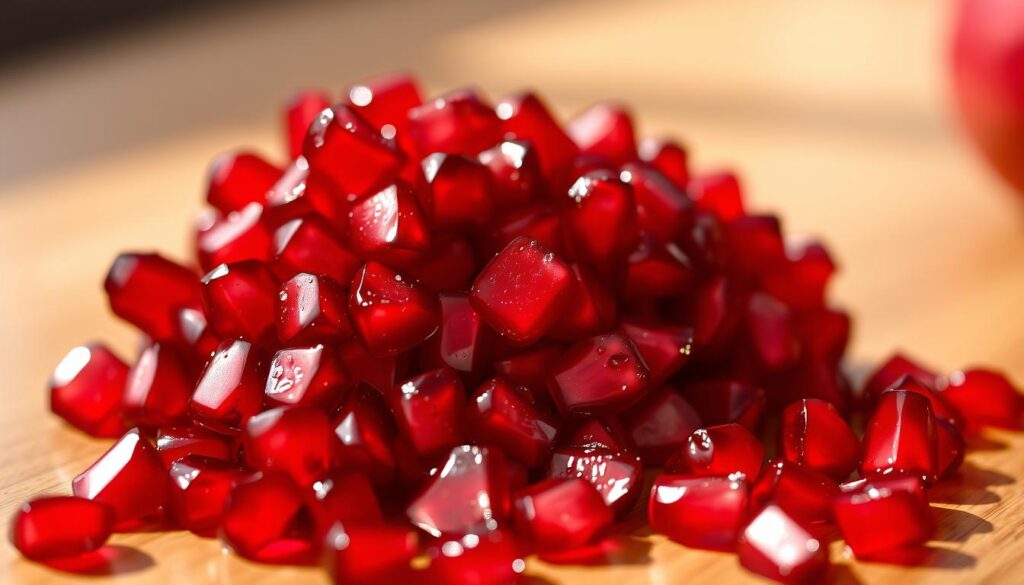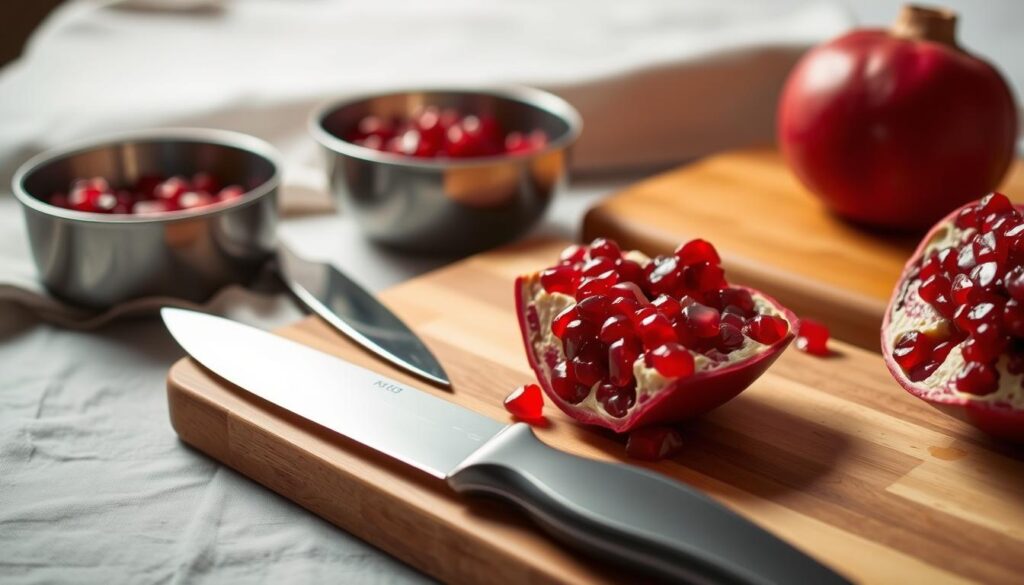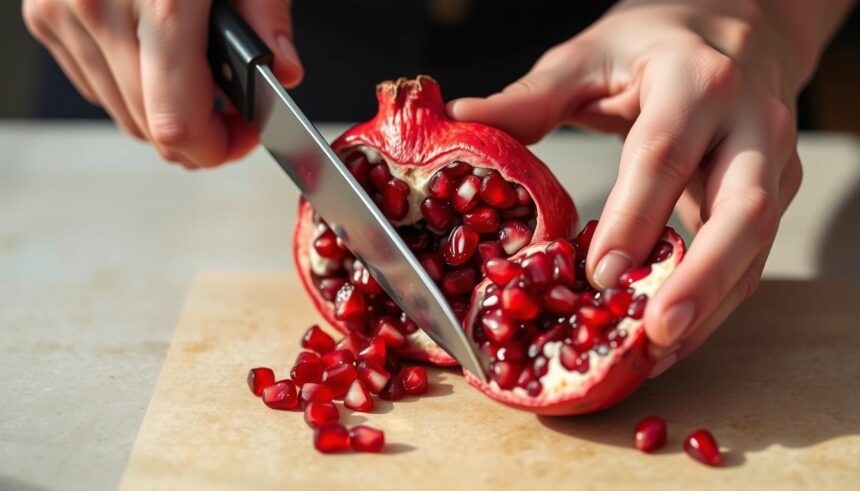Are you tired of the hassle and mess when trying to enjoy pomegranates? You’re not alone. Many of us struggle with deseeding this nutritious fruit. It’s time to change that. With our simple guide, you’ll learn the foolproof method for cutting a pomegranate. This makes it easy to add this superfood to your diet.
Cutting a pomegranate can seem scary, but with the right technique, you’ll enjoy its juicy arils soon. Our step-by-step guide will show you how. You’ll be able to enjoy this nutritious fruit without any hassle.
Key Takeaways
- Learn the simple and effective method for deseeding pomegranates.
- Discover how to minimize mess and maximize enjoyment.
- Understand the benefits of incorporating pomegranates into your diet.
- Get tips on storing and using pomegranate arils.
- Enjoy pomegranates with confidence using our foolproof guide.
Why Pomegranates Are Worth the Effort

Cutting a pomegranate is worth it because of its nutritional benefits and versatility. Pomegranates add flavor to many dishes and are full of nutrients. These nutrients offer health benefits.
Nutritional Benefits of Pomegranates
Pomegranates are a nutritional powerhouse. They are full of antioxidants, vitamins, and minerals. They are rich in vitamin C and potassium.
The antioxidants in pomegranates, like ellagic acid and punicalagins, fight inflammation. They may also protect against certain diseases.
- Rich in Antioxidants: Pomegranates contain powerful antioxidants that help protect cells from damage.
- Anti-Inflammatory: The fruit has been shown to reduce inflammation, which can help with conditions like arthritis.
- Heart Health: Pomegranate juice may help lower blood pressure and improve overall heart health.
Culinary Uses for Pomegranate Seeds
Pomegranate seeds are not just nutritious; they are also versatile in cooking. They add flavor, texture, and nutrition to many dishes. Here are some ways to use them:
- Sprinkling them on salads for a burst of flavor and color.
- Using them as a topping for yogurt or oatmeal.
- Incorporating them into baked goods, such as muffins or cakes.
Adding pomegranate seeds to your diet can make your meals more nutritious and appealing.
Common Challenges When Cutting Pomegranates

Many people love pomegranates but struggle with cutting them. The mess is a big problem. You’re about to learn about the common challenges and how to solve them.
The Messy Reality of Pomegranate Juice Stains
Dealing with pomegranate juice stains is a big challenge. The juice can stain clothes, countertops, and more. Its deep red color makes it hard to clean.
To avoid the mess, be prepared. Wear old clothes or an apron. Also, cover your countertop to catch spills.
Traditional Methods and Their Drawbacks
Traditional ways of cutting pomegranates are often messy. Cutting the fruit in half and trying to remove seeds can splash juice everywhere.
Knowing these common challenges helps find better ways. Look for methods that are cleaner and more efficient.
Essential Tools for Cutting Pomegranates

Before you start cutting your pomegranate, make sure you have the necessary tools. Having the right equipment will make the process much easier and less messy.
Must-Have Kitchen Utensils
To cut a pomegranate efficiently, you’ll need a few basic kitchen utensils. A sharp knife is key for scoring the fruit without too much pressure. This prevents the seeds from bursting.
You’ll also need a cutting board for a stable surface. A large bowl or container is necessary for soaking the pomegranate and collecting the seeds.
Optional Tools That Make the Job Easier
While not necessary, some tools can make cutting a pomegranate easier. A pomegranate deseeder is a handy tool for removing seeds. If you don’t have one, a bowl of water can help loosen the seeds.
Also, a spoon or soft utensil can gently tap out the seeds from the pomegranate’s membrane.
Preparing Your Workspace for Minimal Mess
A clean and stain-resistant workspace is key for easy pomegranate cutting. Preparing your area makes the process smoother and less stressful. Let’s look at how to set up your workspace for cutting pomegranates.
Setting Up a Stain-Proof Cutting Area
To avoid pomegranate juice stains, create a stain-proof cutting area. Start by covering your countertop with a plastic tablecloth or parchment paper. This step protects your surfaces and makes cleanup easy. Choose a cutting board that’s easy to clean, like silicone or plastic.
What to Wear When Handling Pomegranates
Wearing the right clothes is important to avoid stains. Wear an apron to protect your clothes. If you don’t have an apron, wear old clothes or easy-to-clean fabrics. Keep paper towels nearby for quick spills.
| Preparation Step | Benefit |
|---|---|
| Covering countertops | Prevents juice stains on surfaces |
| Wearing an apron | Protects clothing from stains |
| Having paper towels ready | Allows for quick cleanup of spills |
By taking these simple steps, you can cut pomegranates confidently and enjoy their benefits without the mess.
How to Cut a Pomegranate: The Foolproof Method
Now that you have the right tools and a clean workspace, it’s time to learn how to cut a pomegranate. This guide will show you how to enjoy pomegranate seeds easily.
Examining and Washing Your Pomegranate
First, check the pomegranate for any damage or soft spots. Pick one that’s heavy and has a deep red color. Then, rinse it under cold water to get rid of dirt and bacteria.
Scoring the Pomegranate Properly
To score the pomegranate, cut through the skin along the ridges. Be careful not to cut too deep to avoid damaging the seeds. Scoring makes it easier to open the fruit without spilling seeds.
Opening the Fruit Without Spills
After scoring, pull the pomegranate apart into sections. Then, put the sections in a bowl of water. The seeds will sink, and the membrane will float, making it easy to separate them.
Removing Seeds Efficiently
With the pomegranate in water, use your fingers or a spoon to release the seeds. The water keeps the seeds from flying out. Once you’ve removed most seeds, throw away the membrane and any leftover bits.
Separating Seeds from White Membrane
Now, separate the seeds from the white membrane and pith. Skim off the floating membrane and pith, then drain the water. Your pomegranate seeds are now ready to use in salads, as a topping, or as a snack.
By following these steps, you’ll cut a pomegranate efficiently and effectively. This way, you’ll get more delicious, nutritious seeds with less mess. With practice, you’ll become great at cutting pomegranates and enjoy their health benefits every day.
Alternative Cutting Techniques for Different Needs
There are many ways to cut pomegranates, not just one. The right method depends on your situation. Let’s look at some alternatives to find the best one for you.
The Water Bowl Method
The water bowl method is great for avoiding mess. You submerge the pomegranate in water while cutting it. Fill a big bowl with water, score the pomegranate, and then break it apart underwater.
The seeds will sink, and the white pith will float. This makes it easy to separate them. It’s perfect for small kitchens or when cutting many pomegranates at once.
The Spoon Tapping Technique
The spoon tapping technique is also effective. Score the pomegranate, then hold it over a bowl. Gently tap the back with a spoon to release the seeds.
This method is efficient and fun. It’s great for removing seeds without splattering juice.
“The pomegranate is a symbol of abundance and fertility in many cultures, and its seeds are a nutritious addition to a variety of dishes.” – Food Historian
Quick Methods for When You’re in a Hurry
Need to cut a pomegranate fast? Cut it in half and scoop out the seeds with a spoon. It’s not the most efficient, but it works when you’re short on time.
| Method | Time Required | Mess Level |
|---|---|---|
| Foolproof Method | 5 minutes | Low |
| Water Bowl Method | 6 minutes | Very Low |
| Spoon Tapping Technique | 4 minutes | Low |
| Quick Method | 2 minutes | Medium |
Having different techniques helps you adapt to any situation. Whether you want a mess-free method or something quick, there’s a way to do it.
Troubleshooting Common Pomegranate Problems
Working with pomegranates can sometimes lead to a few common issues. These include unripe fruit, stubborn white pith, and pesky juice stains. We have the solutions to help you enjoy your pomegranates without any hassle.
Dealing with Unripe or Overripe Pomegranates
An unripe pomegranate is hard, making it tough to remove the arils. An overripe one is soft and might burst easily. To check if it’s ripe, gently squeeze it. It should be slightly soft but firm.
If it’s not ripe, let it sit at room temperature for a few days. This will help it ripen.
Removing Stubborn White Pith
White pith can stick to the arils, making them less appealing. To remove it, submerge the arils in water. The pith will float, making it easy to skim off.
This method ensures your arils are clean and ready to use.
Fixing Juice Stains on Clothing and Surfaces
Pomegranate juice can stain clothes and surfaces. But, there are ways to remove these stains. For clothes, blot the stain with a clean cloth and then apply a stain remover or baking soda and water mix before washing.
For surfaces, a mix of equal parts water and white vinegar can lift the stain. Always test a small area first to avoid damage.
| Problem | Solution |
|---|---|
| Unripe Pomegranate | Let it ripen at room temperature for a few days |
| Overripe Pomegranate | Use immediately or store in the refrigerator to prolong freshness |
| Stubborn White Pith | Submerge arils in water and skim off the pith |
| Juice Stains | Blot with a clean cloth, use stain remover or baking soda mixture |
Storing and Preserving Your Pomegranate Seeds
Now that you’ve cut your pomegranate, it’s time to store the seeds right. Keeping them fresh is key. We’ll look at short-term and long-term ways to store your seeds.
Short-Term Storage Solutions
For a short time, store seeds in the fridge. Use an airtight container to keep them fresh. Here’s how:
- Rinse the seeds gently with cold water to remove any remaining pith or juice.
- Pat the seeds dry with a paper towel to remove excess moisture.
- Place the seeds in an airtight container, such as a glass jar with a tight-fitting lid.
- Store the container in the refrigerator at a consistent temperature below 40°F (4°C).
Seeds can last up to 5 days in the fridge. Always check on them to keep them fresh.
| Storage Method | Duration | Tips |
|---|---|---|
| Airtight Container in Refrigerator | Up to 5 days | Keep seeds dry, check regularly |
Freezing Pomegranate Seeds for Long-Term Use
Freezing is great for longer storage. It keeps seeds fresh and flavorful all year. Here’s how to freeze them:
- Spread the pomegranate seeds on a baking sheet in a single layer.
- Place the baking sheet in the freezer until the seeds are frozen solid, usually a few hours.
- Transfer the frozen seeds to an airtight container or freezer bag, making sure to remove as much air as possible before sealing.
- Label the container or bag with the date and store it in the freezer.
Freezing correctly, seeds can last up to 12 months. They’re great in smoothies, oatmeal, or yogurt without thawing.
“The secret to enjoying pomegranates throughout the year lies in proper storage. Freezing is a great way to preserve their nutritional value and flavor.”
By using these storage and freezing tips, you can enjoy your pomegranate seeds anytime. They’ll stay delicious and healthy.
Conclusion
You now know how to cut a pomegranate like a pro. This guide showed you easy ways to do it. You can add pomegranates to salads, use them as toppings, or just snack on the seeds.
Now, you can enjoy pomegranates without any hassle. You’ve learned the foolproof method and other techniques. This means you can make the most of this nutritious fruit.
With your new skills, cutting pomegranates will be easy. You’ll make less mess and enjoy it more. Remember, practice makes perfect. It might take some time to get it right.
But as you get better, cutting pomegranates will become second nature. You’ll enjoy the delicious and healthy fruit even more.













